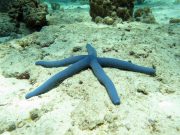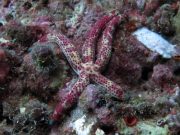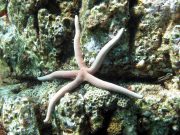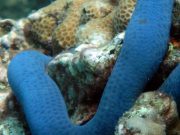Dykning med Slange søstjerner
Koh Lantas Marineliv | Ophidiasteridae
Slangesøstjernerne er en stor familie af søstjerner, der er opkaldt efter de slanke medlemmer af slægten Ophidiaster, som har slangelignende arme. De findes i overflod på alle de steder, hvor vi dykker på Koh Lanta.
Mange arter er farvestrålende og mønstrede og efterligner andre havdyr, som kan være giftige eller farlige at beskytte.
Slangestjerner har flere rækker af rørfødder på undersiden, som kan bruges til at bevæge sig, fornemme omgivelserne og finde føde.
Disse søstjerner kan findes på koral- eller stenrev og over og i sandsubstrat, og de er et almindeligt syn på alle dykkersteder omkring Koh Lanta.
De lever af alger, ådsler, detritus, koralslim, mikroorganismer og svampe. Til gengæld jages de af krabber, fisk, snegle og rejer.
Nogle arter har en bemærkelsesværdig evne til at regenerere, så de kan afkaste og få nye arme, eller reproducere sig ved at afkaste en arm, som så danner en ny skive og nye arme til et nyt individ.
Linckia-slægten, som vi finder på alle dykkersteder omkring Koh Lanta, bliver spist af Harlekin-rejer (Hymenocera picta) og kan få mistede lemmer til at vokse helt ud igen.
2 arter fundet på denne side:
Blue Sea Star
(Linckia laevigata)
The Blue Sea Star is very common, seen at all dive sites around Koh Lanta. This sea star normally has five long, thin arms extending from the small central disc, with rounded tips at each end. The arms are covered in numerous closely packed lines of faint, slightly raised spots.

Linckia laevigata @ Koh Haa
The Blue Sea Star is often blue, but is also found in other colours, beige, orange, red, peach, brown and many variations in between.
The Blue Sea Star grows to 30 cm and are found in shallow water exposed to sunlight, either singly, or in groups. This sea star can be found on the sand or rubble bottom, on rocky walls, on corals, sponges, just about anywhere in the reef area. The diet includes organic matter, dead animals, small invertebrates and anything else tasty that comes their way.
Red Star
(Linckia multifora)

Linckia multifora @ Koh Bida
The Red Star has a small central disc and 5 thin arms which taper toward the end. This species has a very similar shape to the Blue Seastar.
This species has a variable body colour, from cream to grey to brown to red and pink. The body is covered with red spots and many small granulations. A Red Star can grow up to 13 cm in diameter.
The Red Star is capable of self amputation) and often sheds one or more arms, which can then grow into a new individual. The arm detachment process takes up to an hour, with a small crack appearing on an arm, approximately 2.5 cm from the disc. Once the crack has appeared, the tube feet on the arm and the body pull the two parts in opposite directions. The detached arm is known as a 'comet' and moves about independently. It takes about 10 months to regenerate a new disc.
Dykning med Slange søstjerner omkring Koh Lanta
Dykning og snorkelture
Hvis du gerne vil have chancen for at se Slange søstjerner på en af vores daglige dykkerture i højsæsonen fra Koh Lanta, så send os en e-mail til info@diveandrelax.com.
Deltag i vores speedbådsdykkerture i højsæsonen til nogle af Thailands bedste dykkersteder og nyd små grupper, korte rejsetider med fokus på god personlig service, sikkerhed og sjov.
Er du endnu ikke certificeret dykker? Lær at dykke på Koh Lanta med det 3-dages SSI Open Water Diver-kursus.
Book online og spar 10% på dykkerture og dykkerkurser på Koh Lanta.
Få mere at vide
Indo-Stillehavets havdyrsguider
- Allen, G., Steene, R., Humann, P., DeLoach, N. (2003) Reef Fish Identification, Tropical Pacific. Jacksonville, FL., USA: New World Publications, Inc., ISBN 1-878348-36-1.
- Humann, P., DeLoach, N., (2010) Reef Creature Identification, Tropical Pacific. Jacksonville, FL., USA: New World Publications Inc., ISBN 978-1-878348-44-9
- Debelius, H. (2013) Indian Ocean Reef Guide. Frankfurt, Germany: IKAN - Unterwasserarchiv, ISBN 978-3-939767-52-7.
- Debelius, H. (2004) Nudibranchs and Sea Snails, Indo-Pacific Field Guide. Frankfurt, Germany: IKAN - Unterwasserarchiv, ISBN 3-925919-51-1
- Erhardt, H., Knop, D. (2015) Corals Indo-Pacific Field Guide. Frankfurt, Germany: IKAN - Unterwasserarchiv, ISBN 3-925919-69-4.
- Veron J.E.N., Stafford-Smith M.G., Turak E. and DeVantier L.M. (2016). Corals of the World
Flere referencer om havets dyreliv og yderligere information


